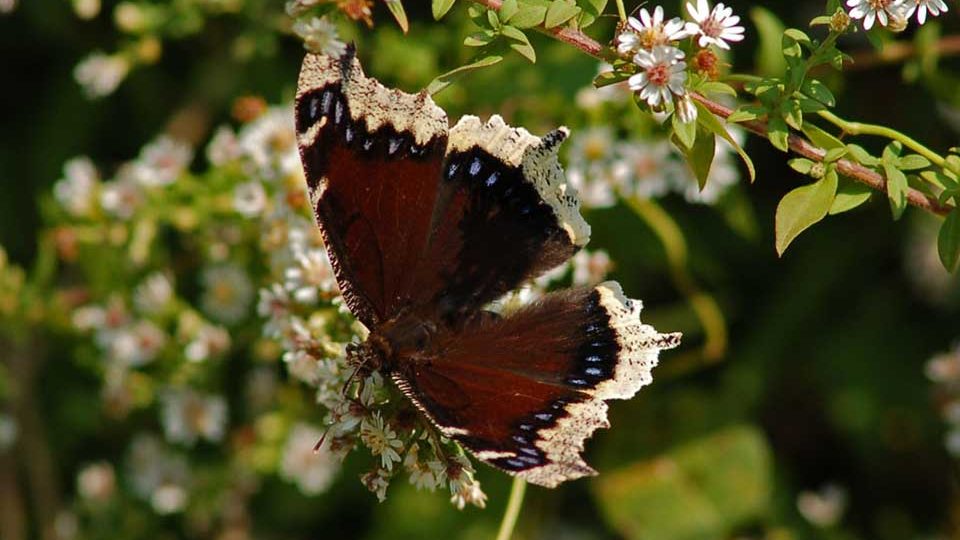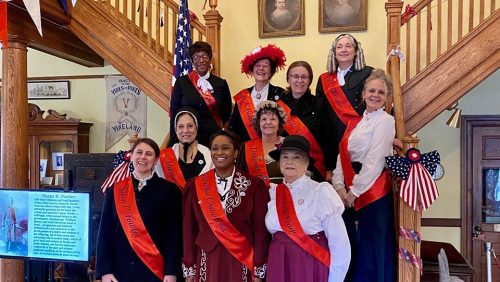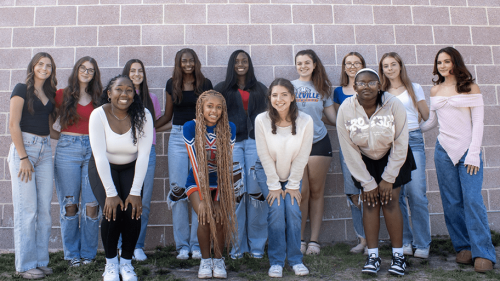
The month of May is when ornithologists and avian fanciers migrate to the shores of the Delaware Bay to study the spawning of the horseshoe crabs and the migratory stopover of shorebirds who feast on their green eggs. A number of species of shorebirds begin their journey on the southern shores of South America, fatten up on the Delaware Bayshore, and continue onward to the Arctic where they will nest. This is a marathon flight of 9,000 miles for the famed red knot and others.
The phenomenon also triggers a number of CU Maurice River’s volunteers to host the shorebird recovery team members for supper during their three-week stay on the Bayshore. Our visiting birds nearly double their weight to fuel their flight to the arctic. The recovery team biologists joke that our volunteers try to fatten them up as much as the birds. The meal delivery is an on-going tradition since 2007.
For me May means that each day I coordinate the volunteers to make sure they are on task and that the team is well fed and hosted. By now our members are like a well-greased wheel and in general are way ahead of me, surpassing any expectations with their delightful menus. But in the mornings I try to spend an hour or two in the garden making it ready to host butterflies, moths, purple martins, hummingbirds, a plethora of other bird species, and whatever else might come our way.
A number of years ago I heard naturalist Pat Sutton speak of the virtues of the hackberry tree as a host or food plant. Ecology professor and lepidopterist David Wagner lists approximately 20 species of moths and butterflies for whom the hackberry tree is a host. The butterflies are mourning cloak, question mark, hackberry emperor, comma, snout, and tawny emperor. Of the 14 identified species of moths, you may be familiar with some of the tussock moths, or one of my favorites, the io moth.
With such a large number of possible visitors I decided to plant a hackberry tree in a prominent place in our driveway’s circle where it could shade ferns beneath it. At the other end of the circle another hackberry, which I did not purchase, volunteered as if to say, “You really didn’t need to buy that tree. I was showing up here anyway.”
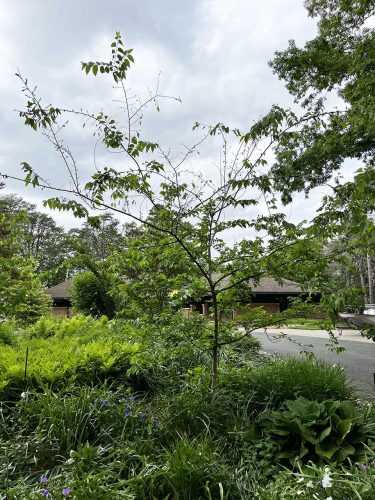 After planting a number of hackberries in the wooded area on our property I became aware that a number of previously unnoticed saplings in our yard were also hackberry. However, this past week, on May 16, I discovered that my intended shade tree was denuded on the top and the volunteer was almost fully stripped of leaves. My first reaction was, “Who’s destroying my hackberry?” Then I remembered, “Duh, that’s why I planted it.”
After planting a number of hackberries in the wooded area on our property I became aware that a number of previously unnoticed saplings in our yard were also hackberry. However, this past week, on May 16, I discovered that my intended shade tree was denuded on the top and the volunteer was almost fully stripped of leaves. My first reaction was, “Who’s destroying my hackberry?” Then I remembered, “Duh, that’s why I planted it.”
On closer inspection I found that the culprits were 53 mourning cloak caterpillars that had me crying the blues (pun intended). After reflection it occurred to me that they are one of my favorite butterflies, so good-bye to the blues—I’m jazzed. I watch them with their black spiny bodies covered in minute white flecks and line of red spots climb about en masse devouring my tree’s leaves and I think, “Well, I’m hosting more than the shorebird team now!”
In our infinite wisdom America’s gardens are filled with non-native invasive species that don’t host a darned thing, unless we are lucky enough to get lantern flies, which feast on the tree-of-heaven—sarcasm intended! We are starving the very wildlife that supports us, along with the birds in our yards. Americans habitually plant trees that support no local wildlife because they don’t want to see a leaf eaten, but if that’s the case you may as well plant plastic replicas.
Truth be told, it is unlikely that a huge oak being eaten by some caterpillars would even be noticed from the road’s edge, from where most people would admire your landscaping. And by the way, oak trees support 534 species of butterflies and moths and many animals, including 29 species of birds. And the caterpillars will feed countless birds’ chicks.
Butterflies, moths, and other insects have evolved in tandem with specific plants over millions of years. The University of Bristol Palaeobiology Research Group suggests that 145-66 million years ago, during the Cretaceous Period, many insect groups were linked to flowering plants. Some, like the monarch butterfly, may only have one food plant source, while others may have multiple hosts.
As an example, the mourning cloak will also make use of willow, cottonwood, poplars, birch, elm, and others. You can’t have butterflies without caterpillars. And you can’t have birds without caterpillars for them to feed their young. In order to host butterflies you have to provide not only nectar sources but food plants, which are equally important.
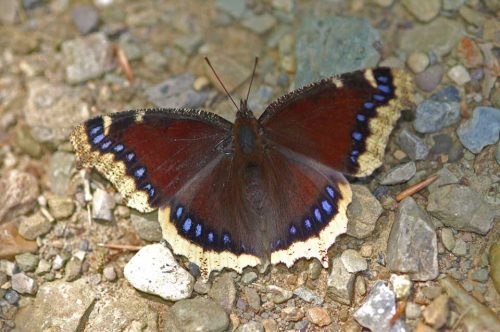
Mourning cloak butterflies are our longest-lived adult butterfly, with some surviving nearly a year. The adult butterfly lays her eggs around a twig. When the young hatch they constitute a living mass and remain so until they disperse for pupating. Their approach to feeding can defoliate a small tree as they did in my front yard. They will emerge midsummer and be dormant until the fall. They overwinter in woodpiles, sheds, and such, but they leave their shelters and are commonly spotted on warm winter days and in the spring.
The mourning cloak is a dark maroon to brown shade, appearing nearly black, with defined borders on the wings being a pale yellow or beige color. Just inside the border are lovely small blue spots within a darker border. Its chrysalis is tan or brown and looks like a dead leaf with spikes along the edge.
All in all, losing the leaves of the hackberry should be worth the shows provided by the butterflies that survive, and the hackberry will likely leaf out again next year.
Just as the horseshoe crabs provide eggs that are essential for feeding migrating shorebirds, you must have food plants in order to host caterpillars so that ultimately you can enjoy butterflies in your garden.
Sources
Caterpillars of Eastern North America, David L. Wagner
Bringing Nature Home, Doug Tallamy
“Coevolution of angiosperms and insects.” University of Bristol Palaeobiology Research Group. Archived from the original on 20 December 2016. Retrieved 16 January 2017.
www.PatSuttonWildlifeGarden.com

